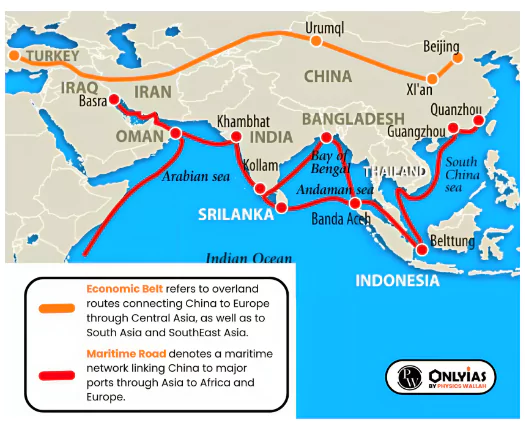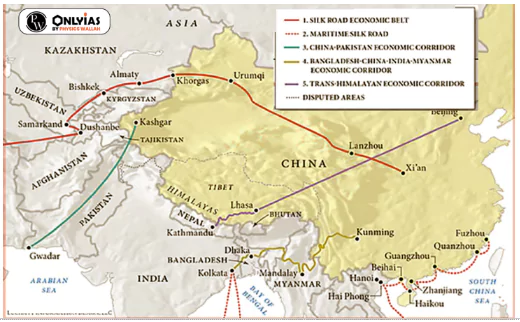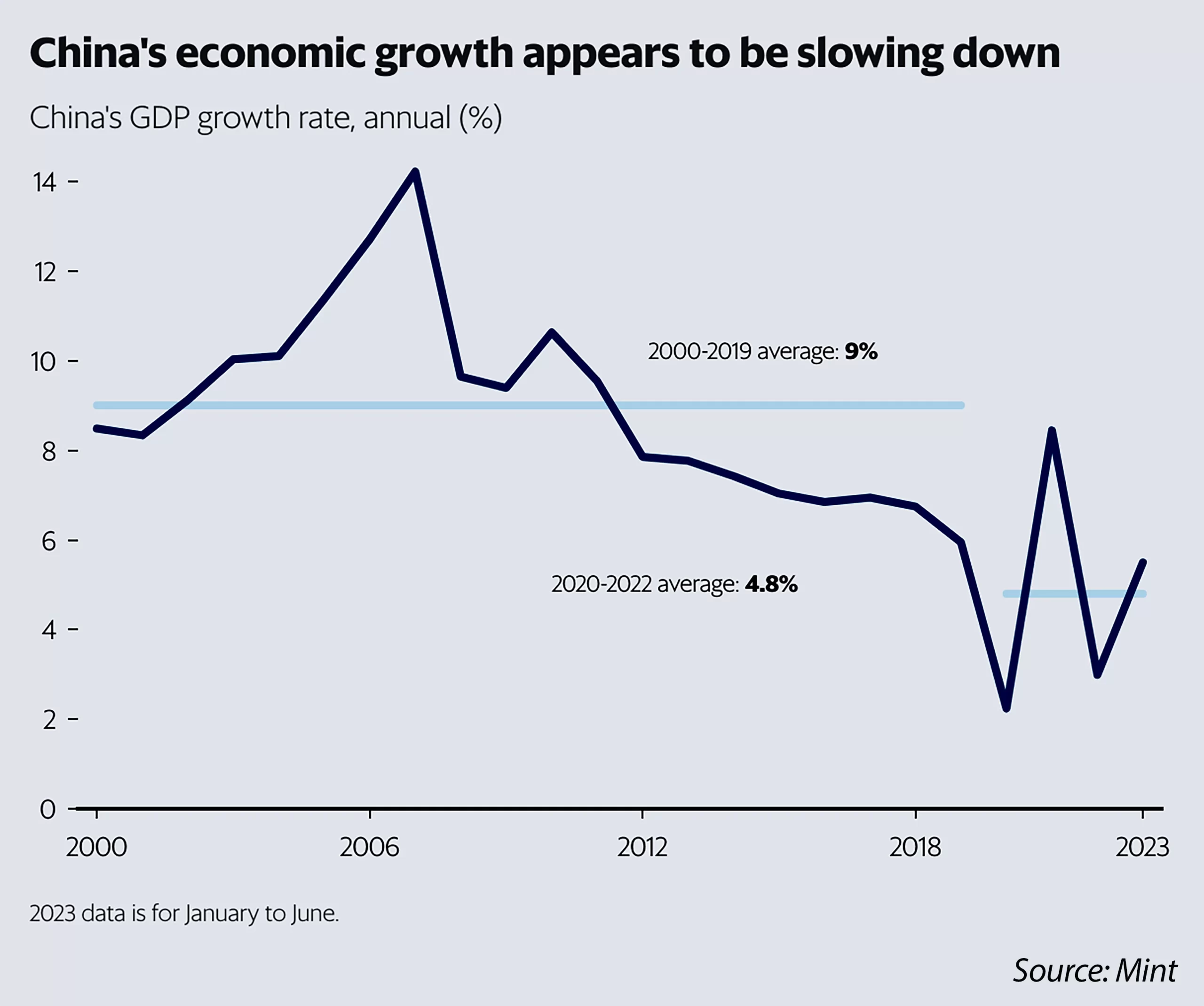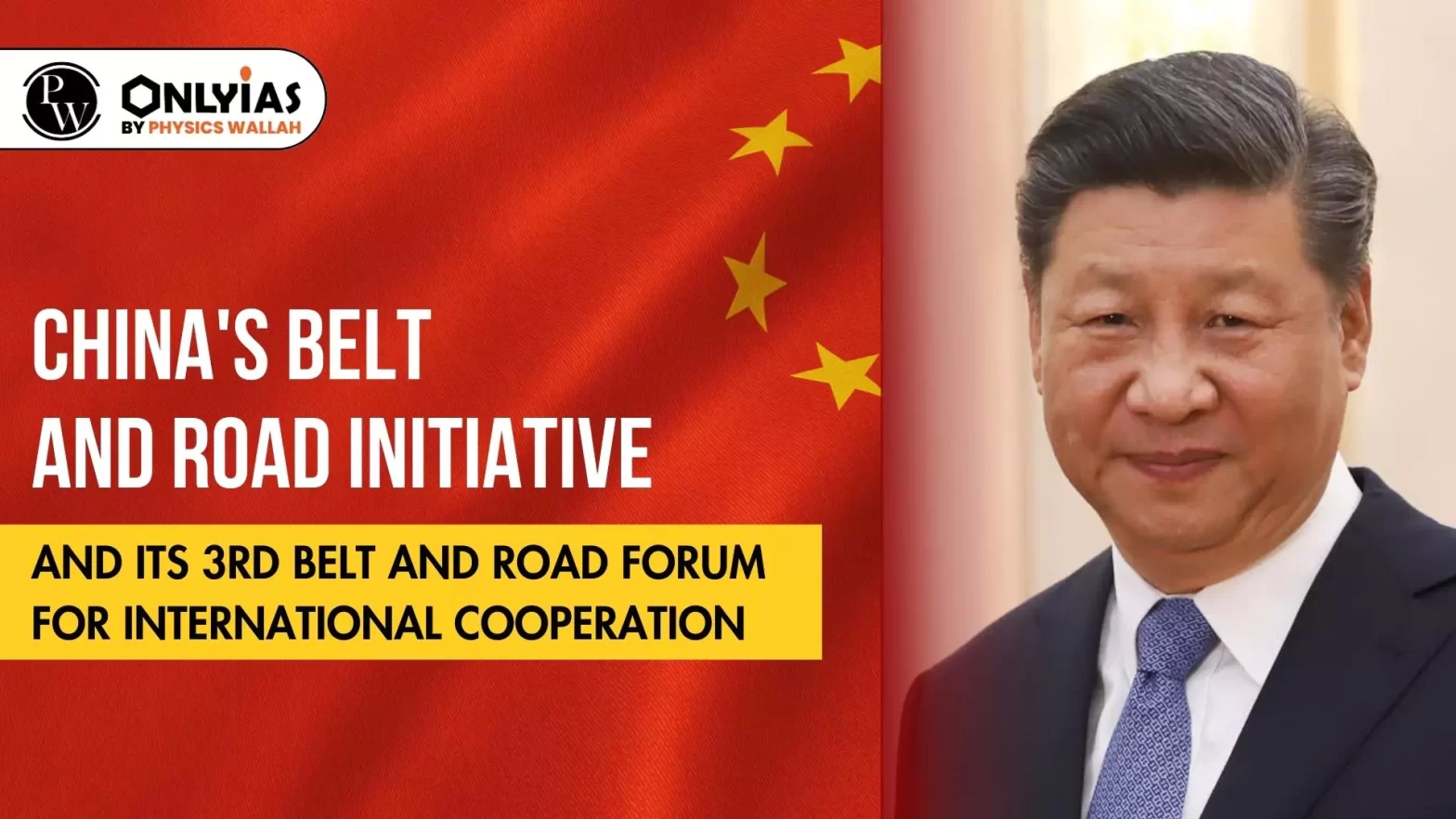Context:
- This article is based on the news “The BRI at 10, some hits, many misses” Which was published in the Hindu. Recently, the third Belt and Road Forum for International Cooperation was convened in Beijing, China. The forum was started by China as a platform for collaboration and networking that would periodically review the broad direction of the BRI, finalize its action agenda, and announce new frameworks and agreements.
| Relevancy for Prelims: Third Belt and Road Forum, Belt and Road Initiative, China–Pakistan Economic Corridor (CPEC) World Bank, and India-Middle East-Europe Corridor.
Relevancy for Mains: China’s Belt and Road Initiative (BRI), its objective, related concerns, India’s stand, and what are alternatives suggested to this BRI. |
Taliban wants to formally join China’s Belt and Road Initiative
- The Taliban administration has expressed its interest in formally joining China’s Belt and Road Initiative and the China-Pakistan Economic Corridor, in a bid to attract investment in Afghanistan.
- Dampening Enthusiasm: About 27 world leaders attended the first forum in Beijing in 2017. That number was 37 in 2019. Only 23 world leaders attended the third forum, suggesting decreased enthusiasm among participating countries to take debt, and China’s less desire to lend.
- Italy, a member of the G7, is also expected to leave the BRI.
What is the China’s Belt and Road Initiative or BRI?
- The Belt and Road Initiative or BRI was launched by Chinese President Xi Jinping in 2013.
- Objective: To connect Asia with Europe and Africa, through a network of railways, highways, ports, airports, and other infrastructure projects with the intent to promote trade, investment, and economic growth in participating countries.
- Principal components: The Silk Road Economic Belt and the Maritime Silk Road
- Geographic Corridors under BRI
- China-Pakistan Economic Corridor (CPEC).
- New Eurasian Land Bridge Economic Corridor.
- China-Indochina Peninsula Economic Corridor.
- China-Mongolia-Russia Economic Corridor.
- China-Central Asia-West Asia Economic Corridor.
- China-Myanmar Economic Corridor.
- Since India refused to join BRI, the BCIM corridor has also stalled, and has been replaced by a later launched China-Myanmar Economic Corridor.
- Renaming from ‘One Belt and one Road’ to to BRI: Earlier, it was named as ‘One Belt One Road’, which brought about numerous misinterpretations, as the partners tend to focus too much on the word “one”, assuming that there is to be only one maritime route and a single land belt, whereas, in reality, “The Belt and Road Initiative aims to connect Asia, Europe and Africa along five routes.”

What are the motivations behind China’s infrastructure investment under the Belt and Road Initiative?
- China’s rivalry with the US: The vast majority of Chinese international trade passes by sea through the Malacca strait off the coast of Singapore which is a major US ally. The initiative is integral to China’s efforts to create its own more secure trade routes.
- Political influence: Enhancing China’s intention is also to make participating nations interdependent with the Chinese economy, and thereby build economic and political influence for China.
- Boosting Development: The Belt and Road serves as a vital tool in China’s efforts to uplift its less affluent central provinces, with the government providing substantial budgets and promoting competition among businesses in these areas to secure contracts.
What is India’s stand on China’s Belt and Road Initiative?
- India strongly opposes China’s Belt and Road Initiative (BRI), particularly the China-Pakistan Economic Corridor (CPEC), because it passes through Pakistan-occupied Kashmir (PoK).
- CPEC (China-Pakistan Economic Corridor) which connects Gwadar Port in Pakistan’s Baluchistan with China’s Xinjiang province is the flagship project of BRI.
- India’s main concern is that this project disregards its sovereignty and territorial integrity.
|
What are the concerns associated with China’s Belt and Road Initiative (BRI)?
- Debt Trap Diplomacy: Nations have borrowed heavily from China for Belt and Road Initiative projects, and they now face challenges in repaying these loans. This has led to accusations of “debt trap diplomacy,” where countries risk losing control of strategic assets if they default on their loans.
- For example, Sri Lanka had to hand over control of the Hambantota port to China due to mounting debt.
- Risks involved with major infrastructure projects: There are potential environmental, social, and corruption risks associated with any large infrastructure project.

-
- For Example: In 2016, China was involved in 240 coal projects in Belt and Road Initiatives countries, responsible for greenhouse gas emissions.
- Macro risks: For some countries, the financing required for BRI projects may expand debt to unsustainable levels.
- For instance, the construction of the Lao PDR section of the Kunming -Singapore Railway has an estimated cost of US$ 6 billion – nearly 40 percent of the GDP of Laos in 2016.
- Slow Pace of Projects: In Pakistan, Belt and Road Initiative projects worth around $19 billion are either completed or underway but that has not provided impetus to structural economic reforms.
- As a result, Pakistan’s economy is on the brink of a default with high amounts of debt, an ever-growing current account deficit and very low foreign exchange reserves.
- Slowdown of Chinese Economy: The recent slowing down of the Chinese economy presents another key challenge to the BRI.
- The Chinese economy grew 5.5% in the first half of 2023, above the official 5% target but below its historical rate. It is also facing deflation and rising youth unemployment.

- Governance Issue: In contrast to initiatives such as the Asian Infrastructure Investment Bank (AIIB), the Belt and Road Initiative (BRI) does not possess a centralised governing framework, which complicates the collective resolution of issues.
What are the proponents of China’s Belt and Road Initiative?
- Tremendous size and scope: BRI economies account for one-third of global GDP and trade, and close to two-thirds of world population. Countries that have joined the BRI have seen a jump in investment and trade with China and preferential treatments in policy, although these are, again, enabled through bilateral arrangements. As the
- White Paper on Belt and Road Initiative noted, between 2013 and 2022, trade with BRI partners grew 6.4% annually reaching $19.1 trillion while total investment reached $380 billion.
- Large unexploited Potential: While BRI economies, including China, have significantly increased their global exports in the past two decades, some countries like Afghanistan, Nepal, Tajikistan, and Laos face challenges such as insufficient infrastructure and weak policies, hindering their trade potential.
- A successful Belt and Road Initiative has the potential to address these gaps and enhance international commerce, particularly for less-integrated economies
- Improving connectivity: It currently takes about 30 days to ship goods from China to Central Europe, with most goods being transported by sea. Shipping goods by train can cut transit time in half, but costs much more.
- If successful, BRI projects stand to make trade easier in some of the world’s most important economic corridors.
- Investment Window: The proponents of the Belt and Road Initiative argue that it is not a debt trap and that the initiative provides much-needed investment and infrastructure for developing countries.
- Moving towards BRI 2.0: Beyond big-ticket infrastructure projects with low short-term returns, BRI partners are moving into strategic sector ties with China, such as 5G network deployment through the Digital Silk Road.
- Amid the U.S.-China technology war., the average deal size has dropped 48% since 2018, making BRI projects smaller but more strategic.
What are the alternatives to China’s Belt and Road Initiative?
- Partnership for Global Infrastructure and Investment: PGII is a West-led initiative to fund global infrastructure projects, seen as a response to China’s Belt and Road Initiative.
- India-Middle East-Europe Corridor (IMEC): It seeks to link India, West Asia, and Europe through railways and shipping lines.
- Global Gateway: The EU aims to raise €300 billion by 2027 to support the financing of high-quality, sustainable infrastructures, which comply with social and environmental standards.
|
Also read: India-China Relationship
Conclusion:
Through Belt and Road Initiative, China has established an investment network to safeguard its interests which has resulted in many low- and middle-income nations accumulating significant debts. In response, global initiatives such as PGII, Global Gateway need to be prioritized for more inclusive and sustainable development.
| Prelims Question (2016)
‘Belt and Road Initiative’ is sometimes mentioned in the news in the context of the affairs of
(a) African Union
(b) Brazil
(c) European Union
(d) China
Ans: (d) |
![]() 21 Oct 2023
21 Oct 2023




